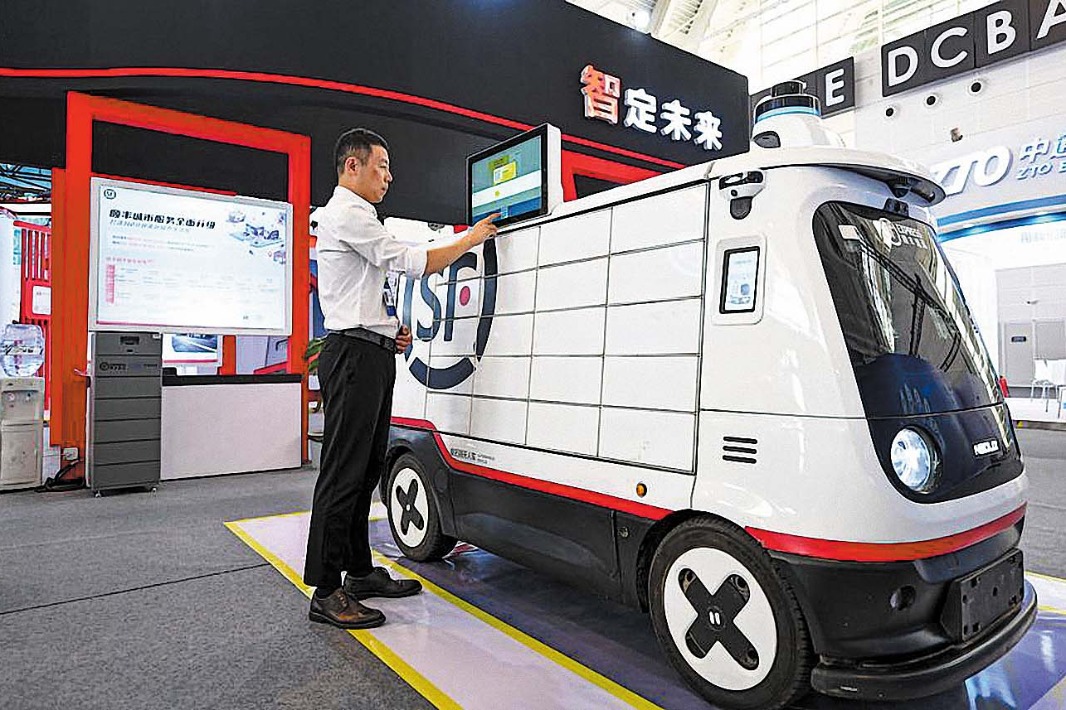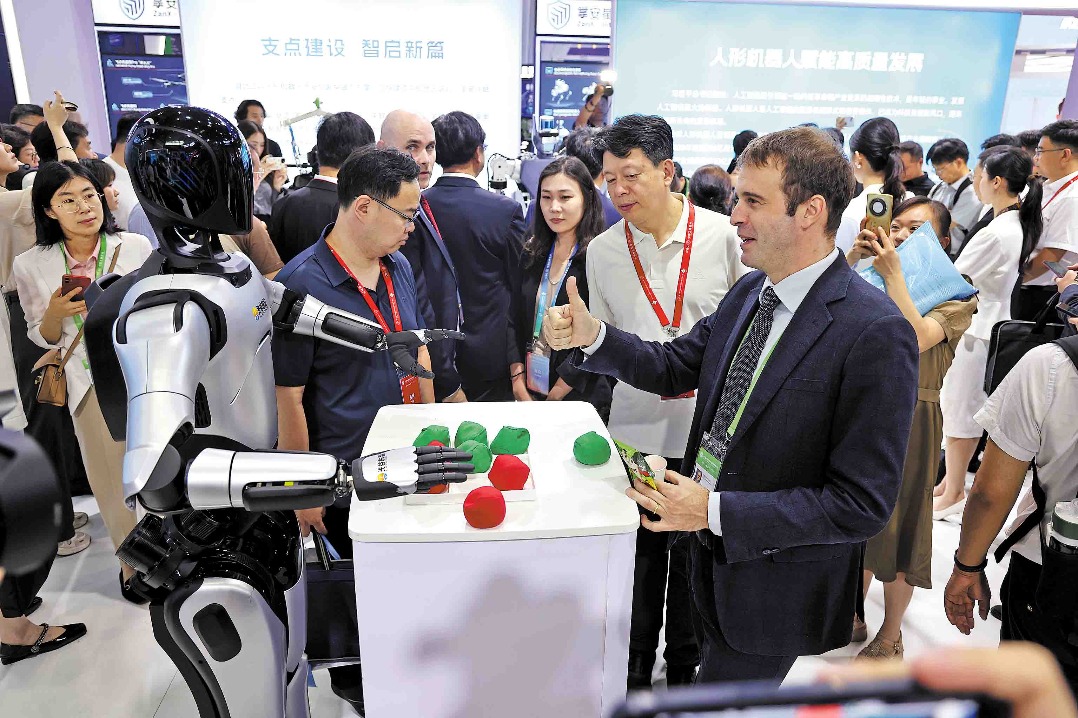High-tech boosts biometric identification


Use of multiple traits, advanced technical tools improves accuracy, security
Editor's note: China aims to nurture 10,000 "little giants" from 2021 to 2025 amid an ambitious plan to trigger the vitality of small and medium-sized enterprises in its sprawling industrial economy. "Little giants" typically specialize in niche sectors, command high market shares and boast strong innovative capacity. To be termed a "little giant", a Chinese firm must see a minimum 5 percent year-on-year average growth rate of its main business income or net profit in the past two years. More importantly, it must have two valid invention patents or other similar proof of its innovation capabilities, and at least 3 percent of its top line must be dedicated to R&D, among other financial and operational criteria. China Daily explores how they help the world's second largest economy stabilize its industrial and supply chains, navigate headwinds from the COVID-19 pandemic and achieve breakthroughs in technology bottlenecks.
Adoption of technology that improves the accurate identification of people by using more than one physical or behavioral characteristic is expected to grow quickly in the next few years, as demand for biometric verification services soars across the globe, industry experts said.
Biometrics technology works by identifying unique features in the biological traits of a person and then comparing them with similar stored information to see if that person is who they say they are. Traits could be physical, such as a fingerprint or iris pattern, or behavioral, such as voice patterns.
What is called multimodal hybrid biometric identification technology combines multiple biometric recognition methods based on new algorithms and characteristics of different biometrics to improve recognition rates.
The integration of advanced technologies such as artificial intelligence and machine learning is expected to give a further push to next-generation biometric systems, experts said.
Chinese AI company Beijing Eyecool Technology Co Ltd plans to expand the ways such identification technologies are used and expand its presence in countries and regions participating in the Belt and Road Initiative, according to the company's senior executive.
Biometric identification collects information on people via biosensors and leverages computers, optical and acoustic analysis and other technological methods to verify individual identities, experts said.
Eyecool, founded in 2016, is engaged in deep learning and the research, development and applications of the technology. Recognition of such characteristics as a person's face or even the pattern of veins in a finger has wide application in areas like finance, public security, government affairs and education.
Zhou Jun, founder and CEO of Eyecool, said technology based on a single biometric recognition factor has some limitations and is unable to meet the needs of all clients, given the large amount of information that needs to be examined and increasing requirements for personal privacy and data security.
Multimodal technology can improve identification accuracy, provide contactless examination of subjects, and enhance data security and reliability, Zhou said.
Eyecool said it had built a multimodal biometric identification system that can be used in different scenarios, such as public security, finance, education and government affairs. The system is designed to manage multiple technologies, applications and products being used and ensure they work together.
Zhou said the company considers the combination of AI, big data and product security to be of great importance, and constantly upgrades its algorithms and models, so as to build an AI-based cyberspace security ecosystem. It will also make full use of its technical advantages to provide efficient, safe and advanced authentication services, he added.
The company has set up six research and development centers nationwide, obtained more than 400 patents, and participated in the formulation of more than 100 national and industrial standards.
Wang Shuqi, chief strategy officer of Eyecool, said the company has worked with 80 percent of banks and financial institutions across the nation, including Industrial and Commercial Bank of China, Agricultural Bank of China, Postal Savings Bank of China and China Minsheng Bank.
In 2017, Eyecool signed agreements with authorities in Xiongan New Area in Hebei province to build a smart city, with biometric identification technology applied in public security, campus security and COVID-19 prevention and control measures.
The company has also signed technical support agreements with public security agencies in more than 20 provinces. In addition, it has set up branches in Europe, the United States and India, and lists more than 1,000 overseas partners.
Wang said the company's fingerprint and iris recognition technologies have passed national tests in India and participated in India's national biometric-based identification system, called Aadhaar, which covers more than 90 percent of the population.
"There is a surging demand for biometric identification technology in Asia, Africa, Latin America and other less-developed regions," Wang said, adding the company will expand its footprint in countries and regions involved in the Belt and Road Initiative.
The global biometrics market has risen from $12.6 billion in 2016 to $28.6 billion in 2021, according to Frost& Sullivan, a US-based business research and consulting firm. Fingerprint and facial recognition are the most widely used biometric technologies currently on the market.
In recent years, global multimodal hybrid biometric technology has developed rapidly. That market increased from $3.3 billion in 2016 to $6.1 billion in 2019, when that technology accounted for 29.2 percent of the global biometrics market.
With its higher reliability and security, multimodal hybrid biometric technology is expected to be used more frequently in a variety of major uses, and its market size is expected to reach $18.1 billion in 2024, with a compound annual growth rate of 25.1 percent, the consultancy said.
"Rapid developments in e-commerce, AI and blockchain are prompting biometric vendors to constantly innovate and make the most of the market demand for advanced biometrics," said Nandini Bhattacharya, industry manager for industrial practice at research and consulting firm Frost & Sullivan.
The increasing adoption of biometric border management, e-passports and facial surveillance in cross-border applications is expanding the market for biometric technologies, especially for fingerprint and facial recognition, said Bhattacharya, adding that the Asia-Pacific region will see the greatest growth due to increased government spending on biometric-authorized applications.
China's biometric identification sector has seen robust growth in recent years, fueled by the government's strong support and spread of intelligent terminal devices and the mobile internet, according to a report released by Shenzhen-based research firm AskCI Consulting.
Its revenue is expected to rise from 12.7 billion yuan ($1.9 billion) in 2016 to 32.6 billion yuan in 2021, with a compound annual growth rate of 20.7 percent over the five years, said the report, which forecasts that the figure would grow to 40 billion yuan in 2022.
"However, along with the acceleration of industries' digitalization and iteration of technologies, there are some bottlenecks that hinder the development of biometric identification technology. For instance, fingerprints can easily be damaged, copied or forged, while facial recognition can involve issues like information misuse and privacy protection," Eyecool's Wang said.
She said two or more biometric recognition methods are often used in identity authentication, especially in areas involving high security. More efforts are needed for enterprises to build core competitiveness in algorithms and products, and to strengthen cooperation and sharing to promote the healthy development of the biometric identification sector, she added.
Biometric recognition is one of the frontier areas to which AI technologies have been applied as China emphasizes technological development, with AI considered a key area.
The government has issued a plan that sets benchmarks for the country's AI sector, with the value of core AI industries predicted to exceed 1 trillion yuan, making the country one of the global leaders in AI innovation by 2030.
AI has become a core driving force for the new round of the technological and industrial revolution in China, bringing tremendous changes to the country's development and people's lives in many fields, including healthcare, education, transportation, security and finance, said Ren Xianliang, chairman of the China Federation of Internet Societies.
During the COVID-19 pandemic, AI-powered technologies have been widely applied in sectors such as source tracing of virus transmissions, virus detection, remote diagnosis and treatment and resource allocation, Ren said.
In 2020, the size of the global AI industry reached $156.5 billion, a year-on-year increase of 12 percent, according to research firm IDC. In China, that number stood at 303.1 billion yuan, up 15 percent from the previous year, according to the China Academy of Information and Communications Technology.
Facial recognition has been one of the biggest emerging technologies over the past few years, as seen in its widespread use in everyday life. For instance, Yitu Technology, a Shanghai-based AI startup, has developed a contactless entrance guard system by applying facial recognition technology, which can identify each visitor within 300 milliseconds, with a 99.9-percent accuracy rate, the company said.
Megvii Technology Inc provides facial recognition technology to Alipay's Smile to Pay option, which allows users to pay using a facial scan on their smartphones.
Yu Xiaohui, deputy director of the China Academy of Information and Communications Technology, said AI companies are making full use of their advantages, and have released various AI-empowered services and products, making contributions in areas such as epidemic monitoring, diagnosis and protection of people's livelihoods.




































